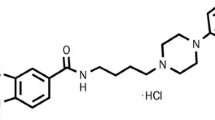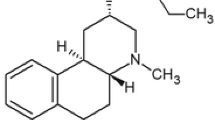Abstract
BRL 34778, exo-4-amino-5-chloro-2-methoxy-N-[9-(4-fluorophenylmethyl)-9-azabicyclo(3.3.1)non-3-yl]-benz amide, is a very potent and specific dopamine D2-receptor antagonist. It exhibits a K i value of 2.14 nM for dopamine D2-receptors but much lower affinity for D1-(K i 5700 nM) and for many other receptor types. Its action is potent and of long duration in models for antipsychotic activity (4 h ED50s PO are 0.017 mg/kg for antagonism of apomorphine-induced climbing in mice and 0.028 mg/kg for antagonism of amphetamine-induced locomotion in rats). In contrast to its high potency in models for antipsychotic activity, BRL 34778 is much weaker in models for extrapyramidal effects and sedation (4 h ED50s PO are 2.4 mg/kg for inducing catalepsy in rats and 1.14 mg/kg for inhibition of rearing behaviour in rats). These data indicate potent activity of BRL 34778 in models for antipsychotic activity but low activity in models for extrapyramidal effects and sedation.
Similar content being viewed by others
References
Alam AS, Imondi AR, Udinsky J, Hagerman LM (1979) Bioavailability of 4C-sulpiride in dogs. Arch Int Pharmacodyn 242:4–13
Alfredsson G, Bjerkenstedt L, Edman G, Harnryd C, Oxenstierna G, Sedvall G, Wiesel F-A (1984) Relationships between drug concentrations in serum and csf, clinical effects and monoaminergic variables in schizophrenic patients treated with sulpiride or chlorpromazine. Acta Psychiatr Scand [Suppl 311] 69:49–74
Arnt J (1982) Pharmacological specificity of conditioned avoidance response inhibition in rats: inhibition by neuroleptics and correlation to dopamine receptor blockade. Acta Pharmacol Toxicol 51:321–329
Benakis A, Rey C (1976) Etude autoradiographique du sulpiride-14C chez la souris et le rat. Localization specifique au niveau de l'hypophyse du rat apres administration unique et administration repetees. J Pharmacol 3:367–378
Benakis A, Pongis MA, Sugnaux F, Vitus F (1976) Localization, distribution, elimination, metabolism and pharmacokinetics of 14C-sulpiride in rats. Eur J Drug Metab Pharmacokinet 1:51–62
Bischoff S, Vassout A, Waldemeier P (1986) The dopaminergic system in the hippocampus: site of action for antipsychotic activity of neuroleptics? in: Woodruff GN, Poat JA, Roberts PJ (eds) Dopaminergic systems and their regulation. Proc satellite symp of 9th IUPHAR Congress of Pharmacology, 1984, Macmillan, London, pp 413–414
Burch NR, Nettleton WJ Jr, Sweeny RJ Jr, Edwards JR (1964) Period analysis of the electroencephalogram on a general purpose digital computer. Ann NY Acad Sci 115:827–843
Campbell W, Clark MSG, Mitchell PJ, Needham PL, Semple JM (1986) BRL 20596, a novel anilide with central dopamine antagonist activity. Psychopharmacology 89:208–215
Carlsson A (1976) The effect of neuroleptic drugs on brain catecholamine metabolism. In: Sedvall G, Uvnas B, Zotterman Y (eds) Antipsychotic drugs: pharmacodynamics and pharmacokinetics. Proc Int Symp Wenner-Gren Centre, Stockholm, 1974. Pergamon, Oxford, pp 99–104
Cassano GB, Castrogiovanni P, Conti L, Bonollo L (1975) Sulpiride versus haloperidol in schizophrenia: A double blind comparative trial. Curr Ther Res 17:189–201
Christensen AV, Arnt J, Hyttel J, Larsen J-J, Svendsen O (1984) Pharmacological effects of a specific dopamine D-1 antagonist SCH 23390 in comparison with neuroleptics. Life Sci 34:1529–1540
Cooper SM, McClelland CM, McRitchie B, Turner DH (1986) BRL 24924: A new and potent gastric motility stimulant. Br J Pharmacol 83:383P
Costall B, Naylor RJ (1973) Is there a relationship between the involvement of extrapyramidal and mesolimbic brain areas with the cataleptic action of neuroleptic agents and their clinical antipsychotic effect? Psychopharmacology 32:161–170
Costall B, Fortune DH, Naylor RJ, Nohria V (1980) The mesolimbic system, denervation and the climbing response in the mouse. Eur J Pharmacol 66:207–215
Costall B, Naylor RJ, Nohria V (1978) Climbing behaviour induced by apomorphine in mice: a potential model for the detection of neuroleptic activity. Eur J Pharmacol 50:39–50
Cross AJ, Crow TJ, Owen F (1986) Post-mortem studies of dopaminergic function in schizophrenia. In: Woodruff GN, Poat JA, Roberts RJ (eds) Dopaminergic systems and their regulation. Proc satellite symp of 9th IUPHAR Congress of Pharmacology, 1984. Macmillan, London, pp 273–284
Crow TJ, Deakin JFW, Longden A (1977) The nucleus accumbens — possible site of antipsychotic action of neuroleptic drugs? Psychol Med 7:213–221
Dunbar AW, McClelland CM, Sanger GJ (1986) BRL 24924: A stimulant of gut motility which is also a potent antagonist of the Bezold-Jarisch reflex in anaesthetised rats. Br J Pharmacol 88:319P
Fleminger S, Van der Waterbreemd H, Rupniak NMJ, Reavill C, Jenner P, Marsden CD (1983) Potent lipophilic substituted benzamide drugs are not selective D-1 dopamine receptor antagonists in the rat. J Pharm Pharmacol 35:363–368
Gouret C (1973) L'epreuve des redressements a l'apomorphine chez la souris: son interet comme test de selection des psychotropes. J Pharmacol 4:341–352
Grilly DM, Jonson SK, Minardo R, Jacoby D, LaRiccia J (1984) How do tranquillizing agents selectivity inhibit conditioned avoidance responding? Psychopharmacology 84:262–267
Hadley MS (1982) Substituted benzamides as dopamine antagonists. In: Creighton AM, Turner S (eds) The chemical regulation of biological mechanisms. R Soc Chem Spec Publ no. 42, pp 140–153
Hadley MS, King FD, McRitchie B, Turner DH, Watts EA (1985) Substituted benzamides with conformationally restricted side chains. 1. Quinolizidine derivatives as selective gastric prokinetic agents. J Med Chem 28:1843–1847
Harnryd C, Bjerkenstedt L, Bjork K, Gullberg B, Oxenstierna G, Sedvall G, Wiesel F-A, Wik G, Aberg-Wistedt A (1984) Clinical evaluation of sulpiride in schizophrenic patients — a double blind comparison with chlorpromazine. Acta Psychiatr Scand [Suppl 311] 69:7–30
Hinson RE, Poulos CX, Thomas WL (1982) Learning in tolerance to haloperidol-induced catalepsy. Prog Neuropsychopharmacol Biol Psychiatry 6:395–398
Iversen SD (1977) Neural substrate mediating amphetamine responses. In: Ellinwood EH, Kilbey MH (eds) Cocaine and other stimulants. Adv Behav Biol 21:31
Jalfre M, Bucher B, Dorme N, Mocquet G, Porsolt RD (1983) Neuropharmacological profile of MD 79051, a new benzamide derivative. Arch Int Pharmacodyn 264:232–256
Janssen PAJ, Niemegeers CJE, Schellekens KHL (1965) Is it possible to predict the clinical effects of neuroleptic drugs (major tranquillizers) from animal data? Part 1. Neuroleptic activity spectra for rats. Arzneimittelforschung 15:104–117
Janssen PAJ, Niemegeers CJE, Schellekens KHL (1966) It is possible to predict the clinical effects of neuroleptic drugs (major tranquillizers) from animal data? Part III: The subcutaneous and oral activity in rats and dogs of 56 neuroleptic drugs in the jumping box test. Arzneimittelforschung 16:339–346
Jenner P, Marsden CD (1979) The substituted benzamides — a novel class of dopamine antagonists. Life Sci 25:479–486
Jenner P, Marsden CD (1985) Neuroleptic agents: acute and chronic actions. In: Horwell DC (ed) Drugs in central nervous system disorders. Clin Pharmacol, Vol 2. Dekker, New York, pp 149–262
Jenner P, Clow A, Reavill C, Theodorou A, Marsden CD (1978) A behavioural and biochemical comparison of dopamine receptor blockade produced by haloperidol with that produced by substituted benzamide drugs. Life Sci 23:545–550
Litchfield JT, Wilcoxon F (1949) A simplified method of evaluating dose-effect experiments. J Pharmacol Exp Ther 96:99–113
Ljungberg T, Ungerstedt U (1985) A rapid and simple behavioural screening method for simultaneous assessment of limbic and striatal blocking effects of neuroleptic drugs. Pharmacol Biochem Behav 23:479–485
Mailman BR, Schulz DW, Lewis MH, Staples L, Rollema H, Dehaven DL (1984) SCH-23390: A selective D1 dopamine antagonist with potent D2 behavioural actions. Eur J Pharmacol 101:159–160
McClelland CM, McRitchie B, Turner DH (1983) BRL 20627: A non dopaminergic blocking stimulant of gastric motility. Br J Pharmacol 80:569P
Miner WD, Sanger GJ (1986) Inhibition of cisplatin-induced vomiting by selective 5-hydroxytryptamine-M receptor antagonism. Br J Pharmacol 88:497–499
Miner WD, Sanger GJ, Turner DH (1986) Comparison of the effect of BRL 24924, metoclopramide and domperidone on cisplatin-induced emesis in the ferret. Br J Pharmacol 88:374P
Mizuchi A, Kitagawa N, Miyachi Y (1983) Regional distribution of sultopride and sulpiride in rat brain measured by radioimmunoassay. Psychopharmacology 81:195–198
Munk-Andersen E, Behnke K, Heltberg J, Nielsen H, Gerlach J (1984) Sulpiride versus haloperidol, a clinical trial in schizophrenia. A preliminary report. Acta Psychiatr Scand [Suppl 311] 69:31–39
Norman JA, Drummond AH, Moser P (1979) Inhibition of calcium-dependent regulator-stimulated phosphodiesterase activity by neuroleptic drugs is unrelated to their clinical efficacy. Mol Pharmacol 16:1089–1094
Ogren SO, Hall H, Kohler C, Magnusson O, Lindbom L-O, Angeby K, Florvall L (1984) Remoxipride, a new potential anti-psychotic compound with selective anti-dopaminergic actions in the rat brain. Eur J Pharmacol 102:459–474
Sarteschi P, Conti L, Cassano GB (1979) Sulpiride in the treatment of psychotic and neurotic syndromes. In: Spano PF, Trabucchi M, Corsini GU, Gessa GL (eds) Sulpride and other benzamides. Italian Brain Research Foundation Press, Milan, pp 269–274
Seeman P (1981) Brain dopamine receptors. Pharmacol Rev 32:229–313
Setler PE, Sarau HM, Zirkle CL, Saunders HL (1978) The central effects of a novel dopamine agonist. Eur J Pharmacol 50:419–430
Snyder SH (1981) Dopamine receptors, neuroleptics, and schizophrenia. Am J Psychiatry 138:460–464
Sousa Moreira LF de, Conceicao Camargo Pinheiro M da, Masur J (1982) Catatonic behaviour induced by haloperidol, increased by retesting and elicited without drug in rats. Pharmacology 25:1–5
Stanley ME, Glick SD (1976) Interaction of drug effects with testing procedures in the measurement of catalepsy. Neuropharmacology 15:393–394
Theodorou AE, Hall MD, Jenner P, Marsden CD (1980) Cation regulation differentiates specific binding of [3H]sulpiride and [3H]spiperone to rat striatal preparations. J Pharm Pharmacol 32:441–444
Uchimura H, Matsumoto T, Hirano M, Kim JS, Nakahara T (1982) Effects of isolation induced behavioural abnormalities and haloperidol on homovanillic acid levels in individual dopaminergic neuron systems of rat brain. In: Kohsaka M, Shohmori T, Tsukada Y, Woodruff GN (eds) Advances in dopamine research. Adv Biosci Vol 37. Pergamon, Oxford, pp 95–106
Usuda S, Noshiro O, Nishikori K, Maeno H (1981) Neuroleptic properties of cis-N-(1-Benzyl-2-methyl-pyrrolidin-3-yl)-5-chloro-2-methoxy-4-methylaminobenzamide (YM 09151–2) with selective antidopaminergic activity. Psychopharmacology 73:103–109
Welch PD (1967) The use of fast fourier transform for the estimation of power spectra: a method based on time averaging over short modified periodograms. I.E.E.E. Trans Audio Electracoust 15:70–73
Westerink BHC, Korf J (1976) Regional rat brain levels of 3,4-dihydroxyphenylacetic acid and homovanillic acid: concurrent fluorometric measurement and influence of drugs. Eur J Pharmacol 38:281–291
Winer BJ (1971) Statistical principle in experimental design. McGraw-Hill, New York
Woodruff GN (1982) Plenary lecture on dopamine receptors. In: Kohsaka M, Shohmori T, Tsukada Y, Woodruff GN (eds) Advances in dopamine research. Adv Biosci Vol. 37. Pergamon, Oxford, pp 1–25
Author information
Authors and Affiliations
Rights and permissions
About this article
Cite this article
Brown, F., Campbell, W., Clark, M.S.G. et al. The selective dopamine antagonist properties of BRL 34778: a novel substituted benzamide. Psychopharmacology 94, 350–358 (1988). https://doi.org/10.1007/BF00174689
Received:
Revised:
Issue Date:
DOI: https://doi.org/10.1007/BF00174689




